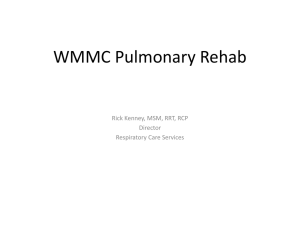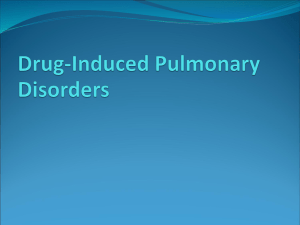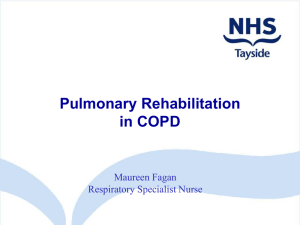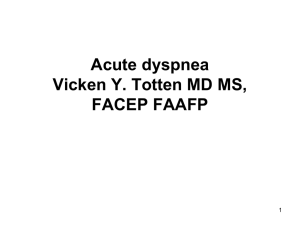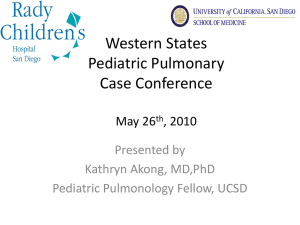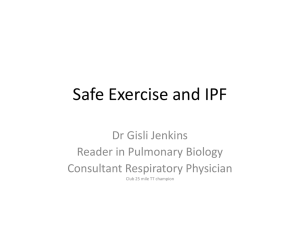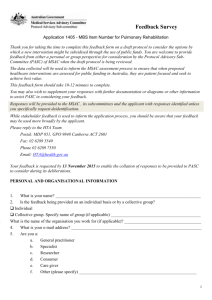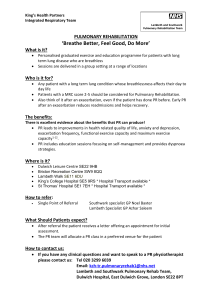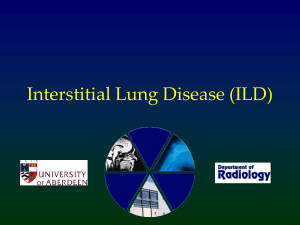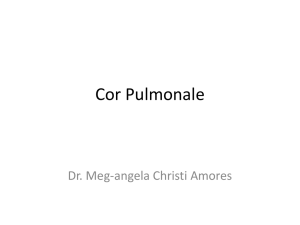to Exercise Prescription for the Pulmonary Patient
advertisement
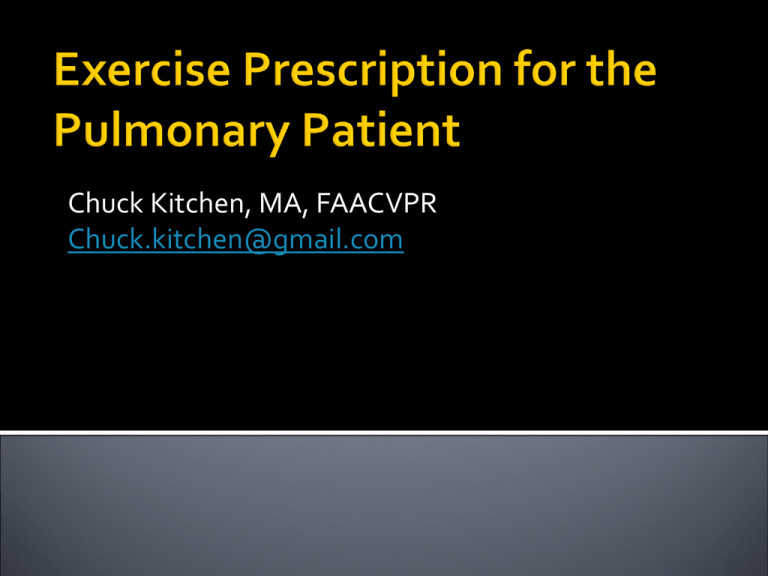
Chuck Kitchen, MA, FAACVPR Chuck.kitchen@gmail.com OBSTRUCTIVE DISEASES COPD-Chronic airway obstruction Emphysema-Hyperinflation of the lungs, can’t get bad air out Chronic Bronchitis-Chronic sputum production and coughing Asthma-increased airway reactivity leading to narrowing of airways PR only covered for Moderate, Severe, Very Severe COPD GOLD classification Chronic lower respiratory diseases ICD-10: J40-J47 Obstructive Lung Disease: Persistent asthma: 493 Bronchitis: 491 Bronchiectasis: 494 COPD: 496 Cystic fibrosis: 277.03 Bronchiolitis obliterans: 491.8 Emphysema: 492 AACVPR, Guidelines for Pulmonary Rehabilitation Programs. 4th ed. 2010, Champaign, IL: Human Kinetics Publishers. Restrictive Lung Diseases: Interstitial diseases: 518.89 (J84.1-9) ▪ Idiopathic interstitial fibrosis: 516.31 (J84.10-J84.111-117) ▪ Other interstitial pulmonary disease with fibrosis: J84.17 ▪ Occupational or environmental lung disease: 518.89(Z57.31) ▪ Sarcoidosis: 517.8 (Lung involvement) (D86.0, 86.2) Chest wall diseases: ▪ Kyphoscoliosis: 737.3 (M41.8) ▪ Ankylosing spondylitis: 720.0 (M45.3-45.5) AACVPR, Guidelines for Pulmonary Rehabilitation Programs. 4th ed. 2010, Champaign, IL: Human Kinetics Publishers. Restrictive Lung Diseases, Continued: Neuromuscular diseases: ▪ Parkinson’s: 332 (G20) ▪ Postpolio syndrome: 138 (G14) ▪ Amyotrophic lateral sclerosis: 335.2 (G12.21) ▪ Diaphragmatic dysfunction: 518.89 (J98.6) ▪ Multiple sclerosis: 340 (G35) ▪ Post-tuberculosis syndrome: 518.89 (A-15) AACVPR, Guidelines for Pulmonary Rehabilitation Programs. 4th ed. 2010, Champaign, IL: Human Kinetics Publishers. Obesity-related Respiratory Disorders: Obesity hypoventilation syndrome: 278.03 Obstructive sleep apnea: 327.23 Other Lung Disorders: Lung cancer: 162 Pulmonary hypertension: 416-417.8 ( Post-lung transplant: V42.6 AACVPR, Guidelines for Pulmonary Rehabilitation Programs. 4th ed. 2010, Champaign, IL: Human Kinetics Publishers. Pulmonary Rehabilitation must be the ONLY service billed using G0424 Sessions limited to a maximum of two 1-hour sessions per day for up to 36 sessions Contractors may approve up to an additional 36 sessions when medically necessary. Providing access of up to 72 sessions of PR, when appropriate Does not specify a duration by which sessions must be completed; allowing the maximum allowable number of 72 over a longer period of time 42.CFR 410.47 9 G0424: Pulmonary rehabilitation, including exercise (includes monitoring), per hour, per session Revenue Code: 0948 Session duration: ▪ One session = > 31 minutes ▪ Two sessions = > 91 minutes, with the first session = 60 minutes and second session = 31 minutes Do NOT bill any other codes for the COPD patient 10 Interstitial Lung Diseases Environmental-asbestos, dust, coal, etc Drugs or chemotherapy Collagen diseases (scleroderma, lupus, etc) Pulmonary fibrosis Vascular Lung Diseases Pulmonary Hypertension 3-5 days per week Walking (preferred) and cycle 20-60 min RPE 5-6 (Moderate) Or 7-8 (Vigorous) for Mild COPD RPE 3-5 for Moderate to Severe COPD No upper extremity recommended Does not use GOLD criteria Strength Training-2-4 sets, 2-3 days/week 0 0.5 1 2 3 4 Nothing at all Very, Very Light Very Light Fairly Light Moderate Somewhat Hard 5 Hard 6 7 Very Hard 8 9 10 Very, Very Hard (Maximal) 3-5 days per week Walking, cycle, arm ergometry, warm-up and cool down 20-90 minutes per session Intensity to achieve patient goals Upper extremity exercise with lower extremity (arm ergometer) Strength Training-Hand weights, free weights, machine weights 3 days per week Cycling or walking > 3o min RPE 4-6 or predetermined MET level Arm ergometer, free weights, elastic bands Strength training-2-4 sets 6-12 reps 6 Min Walk Test-Widely used tool to determine exercise prescription Determine initial exercise intensity F.I.T.T PRINCIPLE Frequency Intensity Time Type FREQUENCY 3 to 5 times per week INTENSITY 4-6 Borg Dyspnea scale 12-14 RPE scale INTENSITY DYSPNEA SCALE (Modified Borg) 0 None 5 Severe 0.5 Very, Very slight 6 1 Very slight 7 Very Severe 2 Slight 8 3 Moderate 9 Very, Very Severe 4 Somewhat severe 10 Maximum INTENSITY RPE SCALE 6 7 very, very light 8 9 very light 10 11 light 12 13 somewhat hard 14 15 hard 16 17 very hard 18 19 very, very hard 20 TIME 20 to 6o minutes Can use interval training especially for beginners or low level patients Total exercise time is most important TYPE Continuous Aerobic High Intensity Interval Training not found to have same benefits as with Cardiac Population (CHF, etc) Possibly due to Dyspnea Low to moderate intensity interval training can be used Resistance Training No data for “optimal” resistance training program Important to help maintain muscle mass (muscle wasting) 1-3 sets 8-12 repetitions 2-3 days per week Exercise capacity often limited by dyspnea, not MET level or RPE, etc SaO2 Monitoring Supplemental O2 to maintain 88%-90% Generally, cycle or other non weight bearing equipment has higher O2 sats Consider continuous exercise on cycle, recumbent stepper, etc. Interval on TM Take bronchodilators prior to exercise Short term benefits from PR Smaller improvements and shorter lasting Typically more dyspnea than obstructive disease Generally more reliant on supplemental O2 Careful to maintain O2 sats above 88%-90% Monitor BP and HR Consider telemetry monitoring Exercise Intensity should be light to moderate ONLY Monitor for lightheadedness, chest pain, etc AACVPR and ACCP do not recognize IMT as part of Pulmonary Rehab Devices used to impose resistance or load Patients increase inspiratory muscle strength Significant decreases in dyspnea Increased walking distance However, no increase in peak power Increased quality of life measures Exercise Prescription is an Art!! Every patient is different 31 American Association of Cardiovascular and Pulmonary Rehabilitation. Guidelines for Cardiac Rehabilitation and Secondary Prevention Programs, 4th ed. Champaign, IL; Human Kinetics, 2010. Garvey C, Fullwood MD, Rigler J. Pulmonary Rehabilitation Exercise Prescription in Chronic Obstructive Lung Disease. JCRP 2013; 33: 314-322 Johnson-Warrington V, Harrison S, Mitchell K, et al. Exercise Capacity and Physical Activity in Patients With COPD and Healthy Subjects Classified as Medical Research Council Dyspnea Scale Grade 2. JCRP 2014; 34(2): 150-154 Ryerson CJ, Cayou C, Toop F, et al. Pulmonary rehabilitation improves long-term outcomes in interstitial lung disease: A prospective cohort study. Respir Med 2014; 108(1): 203-210 Spruit MA, Singh SJ, Garvey C, et al. An Official American Thoracic Society/European Respiratory Society Statement: Key Concepts and Advances in Pulmonary Rehabilitation. Am J Respir Crit Care Med 2013; 188(8): e13-e64

